 There's an old saying: To be a successful gardener, grow
pumpkins. With this truth, you only need one thing to produce pumpkins: seeds!
Still, there are always questions. Surely there's more to it than just placing
the seed in the ground ... What about the fine points? Herewith are a few
questions and answers. They are designed to supplement the tiny print on the
back of most pumpkin seed packets.
There's an old saying: To be a successful gardener, grow
pumpkins. With this truth, you only need one thing to produce pumpkins: seeds!
Still, there are always questions. Surely there's more to it than just placing
the seed in the ground ... What about the fine points? Herewith are a few
questions and answers. They are designed to supplement the tiny print on the
back of most pumpkin seed packets.
What kinds of pumpkins grow the best? Top
Almost any pumpkin seed ultimately will produce
pumpkins. The important question is: what kind of pumpkins do you want to
grow?
 The traditional Jack O'Lantern is a particular variety
officially known as the Connecticut Field Pumpkin. They are usually between
10 and 20 pounds each (though they can grow as big as 50 pounds) and have
a bright orange color and the classic pumpkin shape. It is the picture-book
pumpkin and the one produced by most commerical growers. Looks aside, the
Connecticut Field variety is plain-tasting, not especially sweet, and somewhat
watery for pie. Fortunately there is a vast and varied population in the pumpkin
world. Some of their names bring to mind wrestlers or race horses: Baby Boo,
Munchkin, Spooktacular, Big Max, Cinderella, Lumina, Atlantic Giant ... and
there are many more. Pumpkin varieties come in a wide range of potential sizes
(from a few ounces to over 500 pounds) and in several colors (ranging from
white to pink to red to traditional orange). The big ones require more garden
space, but the leaves and flowers of the different types look remarkably similar.
The traditional Jack O'Lantern is a particular variety
officially known as the Connecticut Field Pumpkin. They are usually between
10 and 20 pounds each (though they can grow as big as 50 pounds) and have
a bright orange color and the classic pumpkin shape. It is the picture-book
pumpkin and the one produced by most commerical growers. Looks aside, the
Connecticut Field variety is plain-tasting, not especially sweet, and somewhat
watery for pie. Fortunately there is a vast and varied population in the pumpkin
world. Some of their names bring to mind wrestlers or race horses: Baby Boo,
Munchkin, Spooktacular, Big Max, Cinderella, Lumina, Atlantic Giant ... and
there are many more. Pumpkin varieties come in a wide range of potential sizes
(from a few ounces to over 500 pounds) and in several colors (ranging from
white to pink to red to traditional orange). The big ones require more garden
space, but the leaves and flowers of the different types look remarkably similar.
Which one to plant? Be my guest. They are all very
willing to enjoy your nurturance. I like to grow several kinds in my United
Pumpkin Nations Patch! They all seem to get along quite well.
It is exciting and satisfying to grow seeds that
have been saved from last year's pumpkins. But there are a few uncertainties
to be noted. First, be sure the seeds were dried in the air, not the oven.
Also there is a possibility that the seed will produce a hybrid -- a cross
between a pumpkin and another kind of squash. These are called Squmpkins and
their color, size, and shape are unpredictable. Still, they are exotic, weird,
and one of a kind.
 Where,
when, and how should the seeds be planted? Top
Where,
when, and how should the seeds be planted? Top
Where: Pumpkins love a sunny spot -- the more
sun the better. Choose a place that gets at least 6 hours of direct sunlight
every day.
When: Seeds can be planted directly in the garden
when the days consistently reach into the low 70's and the spring rains have
tapered off. In colder climates, the seeds can be started indoors and transferred
to the garden when the weather warms. Most pumpkins require 110 to 140 frost-free
growing days. The amount of time depends mainly on the variety, the climate,
and the number of daylight hours during the summer days.
How: Pumpkins seeds typically are planted in the
middle of small hills or mounds that are about three feet in diameter. Surround
each hill with a moat (about 4 inches wide and 4 inches deep) to help contain
water around the roots. Plant 4 to 5 seeds in a circle in the middle of the
hill, and space the seeds about 6 to 8 inches apart.
Thankfully, pumpkin seeds know which way is up,
regardless of how they are set in the ground. Traditionally, the seed is laid
on its side, narrow edge skyward. Soaking the seeds the night before planting
will soften the outer shell and make sprouting easier and faster. But don't
let this little step hold you up if you are suddenly ready to plant. Cover
the seeds with about an inch of soil to block out light and hide them from
hungry birds. The soil should be loosely packed and kept moist but not wet;
think of it as a well-squeezed, damp sponge.
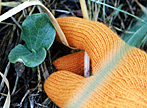 During the seed stage, water gently with a sprinkling
can to avoid washing away the covering soil. Don't peek under the soil or
you may disturb the delicate root hairs that are forming. After 7 to 14 days,
the seed sprout cracks the soil, and within a day, two succulent oval baby
leaves break through and unfold like a pair of opening hands which soon look
like low flying butterflies.
During the seed stage, water gently with a sprinkling
can to avoid washing away the covering soil. Don't peek under the soil or
you may disturb the delicate root hairs that are forming. After 7 to 14 days,
the seed sprout cracks the soil, and within a day, two succulent oval baby
leaves break through and unfold like a pair of opening hands which soon look
like low flying butterflies.
If you are planting more than one hill of pumpkins,
the hills should be 10 feet apart. Once the seedlings are established (two
weeks after they have sprouted), thin to two or three of the strongest and
largest young plants per hill. This may take some courage, and it may seem
impossible to make the right choice. Take heart in the promise of abundance.
In the pumpkin garden, it will surely be fulfilled.
How much room do pumpkins
need? Top
Pumpkin plants are vigorous vines and love to
sprawl. A single vine can grow as long as 30 feet, sending out many vine shoots
all along the way. Looking down from an airplane, it will appear as a carpet
of lush green leaves.
Does this mean pumpkins can't get along with their
neighbors? Absolutely not. The vine can be pruned, trained, and redirected
to live harmoniously with other plants. Pumpkins are often planted at the
edges of a corn and bean patch. The corn supports the climbing beans, and
the pumpkin vines are trained to creep among the corn stalks, The huge leaves
of the pumpkin plant serve as a floating mulch that holds down weeds and keeps
the soil moist. This classic Native American combination -- sometimes called
the three sisters -- not only grows well together, but their blended tastes
and textures make a delicious main course.
 While pumpkins usually keep low to the ground, they can
be encouraged to grow where other plants might never venture. I've seen them
climb over shrubs, up fences and onto roofs. They do this with the help of
their tendrils -- curly grabbers that develop like a hand at every leaf node.
Tendrils are touch sensitive and will tightly curl around any waiting objects
in the path of the vine -- sticks, weeds, plants, anything that has a loose
end. The tendrils keep the vine stable as it reaches out across the garden.
If you train a pumpkin to grow up and onto a flat or slightly sloped shed
roof, it is like adding another floor to your garden. Direct the growing vine
to the side of a building and use 3" galvanized nails (drive them in about
half an inch) as tendril handles. With your guidance, the tendrils will curl
around the nails and ultimately the vine will reach and sprawl along the roof.
When pumpkins develop on the vine as it climbs the building, tack up old nylon
stockings as slings to support the swelling fruit. Or pinch off the baby pumpkins
until the vine reaches the roof. Then let them flourish on their penthouse
porch. Pumpkins on the roof! Your neighbors will drop their jaws as they scan
the horizon.
While pumpkins usually keep low to the ground, they can
be encouraged to grow where other plants might never venture. I've seen them
climb over shrubs, up fences and onto roofs. They do this with the help of
their tendrils -- curly grabbers that develop like a hand at every leaf node.
Tendrils are touch sensitive and will tightly curl around any waiting objects
in the path of the vine -- sticks, weeds, plants, anything that has a loose
end. The tendrils keep the vine stable as it reaches out across the garden.
If you train a pumpkin to grow up and onto a flat or slightly sloped shed
roof, it is like adding another floor to your garden. Direct the growing vine
to the side of a building and use 3" galvanized nails (drive them in about
half an inch) as tendril handles. With your guidance, the tendrils will curl
around the nails and ultimately the vine will reach and sprawl along the roof.
When pumpkins develop on the vine as it climbs the building, tack up old nylon
stockings as slings to support the swelling fruit. Or pinch off the baby pumpkins
until the vine reaches the roof. Then let them flourish on their penthouse
porch. Pumpkins on the roof! Your neighbors will drop their jaws as they scan
the horizon.
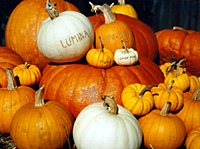 Should
nutrients be added to the soil? Top
Should
nutrients be added to the soil? Top
All the pumpkin seeds packets say: "Plant in
rich soil". But how do you know if your soil is rich enough? If the spot you've
chosen for your pumpkin patch has traditionally grown lots of weeds, then
it definitely has something to offer. But is it rich enough? Soil, like bank
accounts, can always use at least a little bit more. The question then becomes:
What to add? Compost and aged manure are often recommended. Check with a local
garden center for packaged products. Pumpkins are considered "heavy feeders"
and do well with a little extra nourishment. One nutrient source that works
well and is reasonably priced has the dismaying name "fish emulsion". It is
a concentrate of fishy by-products, rich in minerals, that smells a little
like low tide. Add a few glug-glugs (about a quarter of a cup) to a gallon
of water and sprinkle it on each pumpkin mound every three of four weeks.
It is definitely a power booster. There are many "miracle" goods on the market.
They promise a large supply of big pumpkins while posing the question of pushing
versus encouraging the natural process.
What about watering? Top
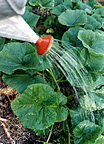 If pumpkins could speak, their first words would probably
be: "Gimme a drink." Between 80 to 90% of every pumpkin is water; and water
is an essential medium for bringing nourishment to the entire plant. Fortunately,
the plant has a built-in water-gathering and water-conservation system: The
huge leaves are a hovering mulch, mediating ground and sky, shading the soil,
keeping it moist, and inhibiting competition from weeds. They also are exquisitely
designed to draw nourishment from the sun and guide water to the base of the
plant. The question is not whether to water pumpkins, but when and how much.
A major factor is the kind of soil in the patch. Sandy soil needs more water
than soil with high deposits of clay. In either case, the rule of thumb is:
turn off the water when puddles appear; and wait till the soil is dry on top
before watering again. It is best to water the plant at the roots rather than
sprinkling from above. Drip systems and soaker hoses are efficient, reasonably
priced, and easy to install. Check with any local garden shop or hardware
store for supplies
If pumpkins could speak, their first words would probably
be: "Gimme a drink." Between 80 to 90% of every pumpkin is water; and water
is an essential medium for bringing nourishment to the entire plant. Fortunately,
the plant has a built-in water-gathering and water-conservation system: The
huge leaves are a hovering mulch, mediating ground and sky, shading the soil,
keeping it moist, and inhibiting competition from weeds. They also are exquisitely
designed to draw nourishment from the sun and guide water to the base of the
plant. The question is not whether to water pumpkins, but when and how much.
A major factor is the kind of soil in the patch. Sandy soil needs more water
than soil with high deposits of clay. In either case, the rule of thumb is:
turn off the water when puddles appear; and wait till the soil is dry on top
before watering again. It is best to water the plant at the roots rather than
sprinkling from above. Drip systems and soaker hoses are efficient, reasonably
priced, and easy to install. Check with any local garden shop or hardware
store for supplies
How do pumpkin plants develop and reproduce? Top
About a week after the two baby leaves appear,
the first "true" leaf, sporting jagged edges, starts to grow from the center
of the young sprout, providing a glimpse of the plant to come. After three
true leaves are established, the pumpkin plant moves into wild and crazy leaf
and root development that lasts about eight weeks. At its peak, the vine can
grow as much as 6" a day.
 Ten weeks after planting, the first flowers suddenly appear
between leaves and tendrils. Each flower blooms for only one day. They start
to unfurl just before dawn, and during a four hour period, they open into
luxurious velvet bowls. By mid-day, they are on a slow course of folding in
on themselves; and by dusk, they are sealed forever.
Ten weeks after planting, the first flowers suddenly appear
between leaves and tendrils. Each flower blooms for only one day. They start
to unfurl just before dawn, and during a four hour period, they open into
luxurious velvet bowls. By mid-day, they are on a slow course of folding in
on themselves; and by dusk, they are sealed forever.
Every pumpkin plant has two kinds of flowers --
male and female. Both are golden yellow, suggesting the color of the fruit
to come. On the surface, males and females look quite similar. However, with
a little observation you can begin to tell them apart. The male flowers, which
appear first, sit on long thin stems and are more plentiful than females.
The females sit closer to the vine and rest like queens on fuzzy round thrones
-- baby pumpkins in waiting.
In pumpkin land, the bees are the matchmakers,
gathering pollen from the center of the males and depositing it inside the
female flower while glutting themselves on sweet nectar. The bees are so busy
with their gathering and guzzling, they are oblivious to onlookers and very
unlikely to sting. So, if you are inclined, arise early in the morning, get
out your binoculars and have a close look. It is like watching the California
gold rush: greedy miners discovering the motherlode. Between watching bee
visits, take a deep breath, and the delicate fragrance of the flower will
add a new reward to your careful peeking.
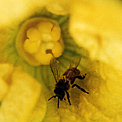 Some avid growers (and seed "manufacturers") imitate the
bees and pollinate the pumpkins manually in order to control and develop certain
traits. The process is quite simple: use a small artist's brush to gather
pollen from the males; carefully carry it to a chosen female and deposit the
pollen by "painting" the center of her flower. To keep out all other would-be
pollinators, place a small paper bag over the female flower and secure it
with a rubber band. Not nearly as exciting as watching the bees, but interesting
in a scientific sort of way.
Some avid growers (and seed "manufacturers") imitate the
bees and pollinate the pumpkins manually in order to control and develop certain
traits. The process is quite simple: use a small artist's brush to gather
pollen from the males; carefully carry it to a chosen female and deposit the
pollen by "painting" the center of her flower. To keep out all other would-be
pollinators, place a small paper bag over the female flower and secure it
with a rubber band. Not nearly as exciting as watching the bees, but interesting
in a scientific sort of way.
Should pumpkin plants be pruned? Top
Pumpkins plants are vigorous growers. Almost
from the beginning, they are like adolescents -- bursting with energy, going
places without permission, and displaying their amazing abilities over and
over again.
Pumpkin vines withstand pruning quite well. Properly
done, it strengthens the plant and helps it thrive. In most cases, the plants
require some cutting if only to keep them from growing into your kitchen.
Every pumpkin plant has a main and a secondary vine that usually grow in opposite
directions. Each of these two vines produce shoots (or tertiary vines) which
can be selectively pruned as the plant develops. It is best to clip when these
new side shoots begin to develop. The plant will leak or bleed a little when
it is clipped, but it seals over quickly. The amount of pruning usually depends
on how much garden space is available. Trimming the plant is definitely necessary
to train the vine to run in a long narrow line along the edge of a garden
and to keep the plants from crawling over each other and their neighbors.
When pruning plants, wear long pants and gloves:
the vines are prickly. As you walk through the garden to check on pumpkins
or to tame runaway vines, remember that there are roots all along the vine
that spread out like a fancy hairdo just beneath the top few inches of soil.
It is best to walk on boards or tiles -- or at least to follow the same path
each time. This will help the soil remain soft and loose and keep the roots
"fluffy" so they can take in water and nutrients.
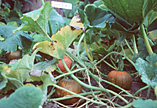 In addition to pruning the vines, some gardeners prune
the fruit -- selecting a few for special attention and removing the rest.
This population control concentrates the energy of the plant and yields larger
but, of course, fewer pumpkins. Wait for the pumpkins to reach grapefruit
size before pruning. Even without selective pruning, all baby pumpkins do
not necessarily grow to maturity and may suddenly yellow and shrivel on the
vine. Perhaps they were not fully pollinated or maybe they were poorly located
on the vine, competing for nourishment with a more developed neighbor. The
harsh truth is that not every tiny pumpkin is destined to make it to the end
of the season.
In addition to pruning the vines, some gardeners prune
the fruit -- selecting a few for special attention and removing the rest.
This population control concentrates the energy of the plant and yields larger
but, of course, fewer pumpkins. Wait for the pumpkins to reach grapefruit
size before pruning. Even without selective pruning, all baby pumpkins do
not necessarily grow to maturity and may suddenly yellow and shrivel on the
vine. Perhaps they were not fully pollinated or maybe they were poorly located
on the vine, competing for nourishment with a more developed neighbor. The
harsh truth is that not every tiny pumpkin is destined to make it to the end
of the season.
What about danger and disease? Top
Pumpkin plants are hardy and strong, but like
all living things, they are vulnerable to outside forces. In the early stages,
the main danger is frost. If the young plants are in the ground and the nights
threaten to become very cold, protect the seedlings with inverted clay flower
pots or a small cold frame, removing the covering each morning. Strong wind
is another threat to the sprawling plant. The tendrils help to hold the vine
down, but sometimes it is necessary to add anchors: u-shaped stakes made from
coat hangers work very well or criss-cross 18" bamboo sticks over the vine.
As the season progresses, many insects and critters
will visit. Almost all are friendly and many are simply on their way to another
land. Even snails seem to overlook pumpkins, preferring, instead, less fuzzy
fare. In different regions, pumpkins are variously plagued by gophers and
moles, vine borers and beetles, aphids and mildew and other unwelcome visitors
and conditions that threaten their security. When these forces find their
way into your patch, they will need to be discouraged. Garden books offer
a wide range of "solutions" ranging from harmless but effective soaps to heavy
duty poisons. Throughout the season, keep an eye out for any irregularities,
especially in the leaves (both the top and bottom). To diagnose the problem,
take a sample to the garden center, another  knowledgeable
gardener, or the library (where the best books have pictures of squash plants
and their problems). As with your own health, early detection is the best
way to prevent a major problem and usually requires the least intervention.
My own preference is to keep the patch as organic as possible. A healthy well-fed
plant, basking in sunlight, unburdened by competition from weeds, and properly
watered has the best chance of successfully resisting danger as well as recovering
from attack.
knowledgeable
gardener, or the library (where the best books have pictures of squash plants
and their problems). As with your own health, early detection is the best
way to prevent a major problem and usually requires the least intervention.
My own preference is to keep the patch as organic as possible. A healthy well-fed
plant, basking in sunlight, unburdened by competition from weeds, and properly
watered has the best chance of successfully resisting danger as well as recovering
from attack.
What should be done to take care for the developing fruit? Top
The basic rule for taking care of the developing
pumpkin fruit is to handle it as little as possible. At the same time, there
are a few widely practiced interventions. First, to encourage the classic
pumpkin look (round as opposed to lop-sided), adjust the fruit so that it's
bottom or flower-end is sitting squarely on the ground. This pumpkin "chiropractics"
should be done after the fruit is well-established -- usually a month after
its appearance and when the flower has dried and fallen off. Gently but firmly
lift the stem and the vine together with one hand, the pumpkin with the other,
and slowly rotate the position of the fruit without using undue force. You
may have to cut or loosen a few surrounding tendrils before lifting. At this
point, pumpkin "complexion" can be helped by slipping a shingle between the
young pumpkin and the soil. This prevents scarring or bruising as the pumpkin
grows and rotting if the soil becomes too soggy. Wear gloves; those vines
are prickly; and take care not to crease or snap the vine.
 Many people, especially kids, like to personalize their
pumpkins -- inscribe their names or draw a picture or a face on one of their
growing treasures. Perhaps it has something to do with the urge to establish
ownership, engage in primitive tribal scarring, or simply to co-create with
nature. Wait until the pumpkin is about 3 to 4 weeks old or developed enough
to have smooth, slightly toughened skin (all fuzz long gone). Any blunt tool
will do; a large nail works fine or even a ball point pen. Break the skin
and don't penetrate more than 1/8 inch. There will be some "bleeding" for
a few hours after surgery. Wipe the marking during the next few hours, and
it should seal within a day. At first, it may be hard to see the results;
but the scar will show in time and will grow in size along with the pumpkin.
Many people, especially kids, like to personalize their
pumpkins -- inscribe their names or draw a picture or a face on one of their
growing treasures. Perhaps it has something to do with the urge to establish
ownership, engage in primitive tribal scarring, or simply to co-create with
nature. Wait until the pumpkin is about 3 to 4 weeks old or developed enough
to have smooth, slightly toughened skin (all fuzz long gone). Any blunt tool
will do; a large nail works fine or even a ball point pen. Break the skin
and don't penetrate more than 1/8 inch. There will be some "bleeding" for
a few hours after surgery. Wipe the marking during the next few hours, and
it should seal within a day. At first, it may be hard to see the results;
but the scar will show in time and will grow in size along with the pumpkin.
When should pumpkins be picked? Top
By late August, the days and nights grow colder
and the green pumpkins begin to change colors like the fall leaves. As the
fruit ripens, the vine displays the inevitable signs of age: older leaves
become tattered, fewer flowers bloom and the energy of the plant seems to
turn more inward, focusing on the fruit filled with the seeds that hold the
promise of the future. Eventually, the scraggly vines lie like skeletons through
the garden while the pumpkins -- fiery skulls that have trapped the energy
of summer -- are scattered throughout. At this point, it is always good to
invite a friend over to marvel at the fruit and to help to adjust to the shifting
mood of the garden.
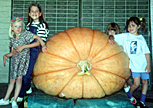 Pumpkins are ready to harvest once the color of the fruit
has deepened into one of the shades of the setting sun -- somewhere between
deep yellow and fiery red, depending on the variety. Leave several inches
of stem -- it helps them stay fresh -- and let them cure in the sun for 10
days. Cover them at night if there is danger of frost. Then, store the harvest
in a dry cool place. With proper care, you may just have pumpkins until Spring.
Pumpkins are ready to harvest once the color of the fruit
has deepened into one of the shades of the setting sun -- somewhere between
deep yellow and fiery red, depending on the variety. Leave several inches
of stem -- it helps them stay fresh -- and let them cure in the sun for 10
days. Cover them at night if there is danger of frost. Then, store the harvest
in a dry cool place. With proper care, you may just have pumpkins until Spring.
There may be more questions. There are always
more questions. Rest assured that pumpkins do not require answers. All through
the growing season, these gregarious, lush plants display extraordinary vitality.
As natives to the American continent, they reflect the American spirit --
generous, innovative, filled with energy, drawing resources and nourishment
from every possible corner, and imposing their presence wherever they grow.
And the fruit, the largest in the vegetable kingdom, has inspired cooks to
prepare delicious food and kids to carve horrific faces. Hail to pumpkins
-- nurturing body and arousing spirit. We are honored to witness your glory!
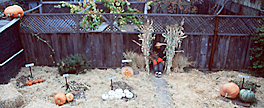


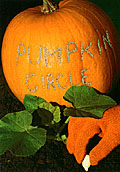

 There's an old saying: To be a successful gardener, grow
pumpkins. With this truth, you only need one thing to produce pumpkins: seeds!
Still, there are always questions. Surely there's more to it than just placing
the seed in the ground ... What about the fine points? Herewith are a few
questions and answers. They are designed to supplement the tiny print on the
back of most pumpkin seed packets.
There's an old saying: To be a successful gardener, grow
pumpkins. With this truth, you only need one thing to produce pumpkins: seeds!
Still, there are always questions. Surely there's more to it than just placing
the seed in the ground ... What about the fine points? Herewith are a few
questions and answers. They are designed to supplement the tiny print on the
back of most pumpkin seed packets. The traditional Jack O'Lantern is a particular variety
officially known as the Connecticut Field Pumpkin. They are usually between
10 and 20 pounds each (though they can grow as big as 50 pounds) and have
a bright orange color and the classic pumpkin shape. It is the picture-book
pumpkin and the one produced by most commerical growers. Looks aside, the
Connecticut Field variety is plain-tasting, not especially sweet, and somewhat
watery for pie. Fortunately there is a vast and varied population in the pumpkin
world. Some of their names bring to mind wrestlers or race horses: Baby Boo,
Munchkin, Spooktacular, Big Max, Cinderella, Lumina, Atlantic Giant ... and
there are many more. Pumpkin varieties come in a wide range of potential sizes
(from a few ounces to over 500 pounds) and in several colors (ranging from
white to pink to red to traditional orange). The big ones require more garden
space, but the leaves and flowers of the different types look remarkably similar.
The traditional Jack O'Lantern is a particular variety
officially known as the Connecticut Field Pumpkin. They are usually between
10 and 20 pounds each (though they can grow as big as 50 pounds) and have
a bright orange color and the classic pumpkin shape. It is the picture-book
pumpkin and the one produced by most commerical growers. Looks aside, the
Connecticut Field variety is plain-tasting, not especially sweet, and somewhat
watery for pie. Fortunately there is a vast and varied population in the pumpkin
world. Some of their names bring to mind wrestlers or race horses: Baby Boo,
Munchkin, Spooktacular, Big Max, Cinderella, Lumina, Atlantic Giant ... and
there are many more. Pumpkin varieties come in a wide range of potential sizes
(from a few ounces to over 500 pounds) and in several colors (ranging from
white to pink to red to traditional orange). The big ones require more garden
space, but the leaves and flowers of the different types look remarkably similar.

 During the seed stage, water gently with a sprinkling
can to avoid washing away the covering soil. Don't peek under the soil or
you may disturb the delicate root hairs that are forming. After 7 to 14 days,
the seed sprout cracks the soil, and within a day, two succulent oval baby
leaves break through and unfold like a pair of opening hands which soon look
like low flying butterflies.
During the seed stage, water gently with a sprinkling
can to avoid washing away the covering soil. Don't peek under the soil or
you may disturb the delicate root hairs that are forming. After 7 to 14 days,
the seed sprout cracks the soil, and within a day, two succulent oval baby
leaves break through and unfold like a pair of opening hands which soon look
like low flying butterflies.  While pumpkins usually keep low to the ground, they can
be encouraged to grow where other plants might never venture. I've seen them
climb over shrubs, up fences and onto roofs. They do this with the help of
their tendrils -- curly grabbers that develop like a hand at every leaf node.
Tendrils are touch sensitive and will tightly curl around any waiting objects
in the path of the vine -- sticks, weeds, plants, anything that has a loose
end. The tendrils keep the vine stable as it reaches out across the garden.
If you train a pumpkin to grow up and onto a flat or slightly sloped shed
roof, it is like adding another floor to your garden. Direct the growing vine
to the side of a building and use 3" galvanized nails (drive them in about
half an inch) as tendril handles. With your guidance, the tendrils will curl
around the nails and ultimately the vine will reach and sprawl along the roof.
When pumpkins develop on the vine as it climbs the building, tack up old nylon
stockings as slings to support the swelling fruit. Or pinch off the baby pumpkins
until the vine reaches the roof. Then let them flourish on their penthouse
porch. Pumpkins on the roof! Your neighbors will drop their jaws as they scan
the horizon.
While pumpkins usually keep low to the ground, they can
be encouraged to grow where other plants might never venture. I've seen them
climb over shrubs, up fences and onto roofs. They do this with the help of
their tendrils -- curly grabbers that develop like a hand at every leaf node.
Tendrils are touch sensitive and will tightly curl around any waiting objects
in the path of the vine -- sticks, weeds, plants, anything that has a loose
end. The tendrils keep the vine stable as it reaches out across the garden.
If you train a pumpkin to grow up and onto a flat or slightly sloped shed
roof, it is like adding another floor to your garden. Direct the growing vine
to the side of a building and use 3" galvanized nails (drive them in about
half an inch) as tendril handles. With your guidance, the tendrils will curl
around the nails and ultimately the vine will reach and sprawl along the roof.
When pumpkins develop on the vine as it climbs the building, tack up old nylon
stockings as slings to support the swelling fruit. Or pinch off the baby pumpkins
until the vine reaches the roof. Then let them flourish on their penthouse
porch. Pumpkins on the roof! Your neighbors will drop their jaws as they scan
the horizon. 
 If pumpkins could speak, their first words would probably
be: "Gimme a drink." Between 80 to 90% of every pumpkin is water; and water
is an essential medium for bringing nourishment to the entire plant. Fortunately,
the plant has a built-in water-gathering and water-conservation system: The
huge leaves are a hovering mulch, mediating ground and sky, shading the soil,
keeping it moist, and inhibiting competition from weeds. They also are exquisitely
designed to draw nourishment from the sun and guide water to the base of the
plant. The question is not whether to water pumpkins, but when and how much.
A major factor is the kind of soil in the patch. Sandy soil needs more water
than soil with high deposits of clay. In either case, the rule of thumb is:
turn off the water when puddles appear; and wait till the soil is dry on top
before watering again. It is best to water the plant at the roots rather than
sprinkling from above. Drip systems and soaker hoses are efficient, reasonably
priced, and easy to install. Check with any local garden shop or hardware
store for supplies
If pumpkins could speak, their first words would probably
be: "Gimme a drink." Between 80 to 90% of every pumpkin is water; and water
is an essential medium for bringing nourishment to the entire plant. Fortunately,
the plant has a built-in water-gathering and water-conservation system: The
huge leaves are a hovering mulch, mediating ground and sky, shading the soil,
keeping it moist, and inhibiting competition from weeds. They also are exquisitely
designed to draw nourishment from the sun and guide water to the base of the
plant. The question is not whether to water pumpkins, but when and how much.
A major factor is the kind of soil in the patch. Sandy soil needs more water
than soil with high deposits of clay. In either case, the rule of thumb is:
turn off the water when puddles appear; and wait till the soil is dry on top
before watering again. It is best to water the plant at the roots rather than
sprinkling from above. Drip systems and soaker hoses are efficient, reasonably
priced, and easy to install. Check with any local garden shop or hardware
store for supplies  Ten weeks after planting, the first flowers suddenly appear
between leaves and tendrils. Each flower blooms for only one day. They start
to unfurl just before dawn, and during a four hour period, they open into
luxurious velvet bowls. By mid-day, they are on a slow course of folding in
on themselves; and by dusk, they are sealed forever.
Ten weeks after planting, the first flowers suddenly appear
between leaves and tendrils. Each flower blooms for only one day. They start
to unfurl just before dawn, and during a four hour period, they open into
luxurious velvet bowls. By mid-day, they are on a slow course of folding in
on themselves; and by dusk, they are sealed forever.  Some avid growers (and seed "manufacturers") imitate the
bees and pollinate the pumpkins manually in order to control and develop certain
traits. The process is quite simple: use a small artist's brush to gather
pollen from the males; carefully carry it to a chosen female and deposit the
pollen by "painting" the center of her flower. To keep out all other would-be
pollinators, place a small paper bag over the female flower and secure it
with a rubber band. Not nearly as exciting as watching the bees, but interesting
in a scientific sort of way.
Some avid growers (and seed "manufacturers") imitate the
bees and pollinate the pumpkins manually in order to control and develop certain
traits. The process is quite simple: use a small artist's brush to gather
pollen from the males; carefully carry it to a chosen female and deposit the
pollen by "painting" the center of her flower. To keep out all other would-be
pollinators, place a small paper bag over the female flower and secure it
with a rubber band. Not nearly as exciting as watching the bees, but interesting
in a scientific sort of way.  In addition to pruning the vines, some gardeners prune
the fruit -- selecting a few for special attention and removing the rest.
This population control concentrates the energy of the plant and yields larger
but, of course, fewer pumpkins. Wait for the pumpkins to reach grapefruit
size before pruning. Even without selective pruning, all baby pumpkins do
not necessarily grow to maturity and may suddenly yellow and shrivel on the
vine. Perhaps they were not fully pollinated or maybe they were poorly located
on the vine, competing for nourishment with a more developed neighbor. The
harsh truth is that not every tiny pumpkin is destined to make it to the end
of the season.
In addition to pruning the vines, some gardeners prune
the fruit -- selecting a few for special attention and removing the rest.
This population control concentrates the energy of the plant and yields larger
but, of course, fewer pumpkins. Wait for the pumpkins to reach grapefruit
size before pruning. Even without selective pruning, all baby pumpkins do
not necessarily grow to maturity and may suddenly yellow and shrivel on the
vine. Perhaps they were not fully pollinated or maybe they were poorly located
on the vine, competing for nourishment with a more developed neighbor. The
harsh truth is that not every tiny pumpkin is destined to make it to the end
of the season.  knowledgeable
gardener, or the library (where the best books have pictures of squash plants
and their problems). As with your own health, early detection is the best
way to prevent a major problem and usually requires the least intervention.
My own preference is to keep the patch as organic as possible. A healthy well-fed
plant, basking in sunlight, unburdened by competition from weeds, and properly
watered has the best chance of successfully resisting danger as well as recovering
from attack.
knowledgeable
gardener, or the library (where the best books have pictures of squash plants
and their problems). As with your own health, early detection is the best
way to prevent a major problem and usually requires the least intervention.
My own preference is to keep the patch as organic as possible. A healthy well-fed
plant, basking in sunlight, unburdened by competition from weeds, and properly
watered has the best chance of successfully resisting danger as well as recovering
from attack.  Many people, especially kids, like to personalize their
pumpkins -- inscribe their names or draw a picture or a face on one of their
growing treasures. Perhaps it has something to do with the urge to establish
ownership, engage in primitive tribal scarring, or simply to co-create with
nature. Wait until the pumpkin is about 3 to 4 weeks old or developed enough
to have smooth, slightly toughened skin (all fuzz long gone). Any blunt tool
will do; a large nail works fine or even a ball point pen. Break the skin
and don't penetrate more than 1/8 inch. There will be some "bleeding" for
a few hours after surgery. Wipe the marking during the next few hours, and
it should seal within a day. At first, it may be hard to see the results;
but the scar will show in time and will grow in size along with the pumpkin.
Many people, especially kids, like to personalize their
pumpkins -- inscribe their names or draw a picture or a face on one of their
growing treasures. Perhaps it has something to do with the urge to establish
ownership, engage in primitive tribal scarring, or simply to co-create with
nature. Wait until the pumpkin is about 3 to 4 weeks old or developed enough
to have smooth, slightly toughened skin (all fuzz long gone). Any blunt tool
will do; a large nail works fine or even a ball point pen. Break the skin
and don't penetrate more than 1/8 inch. There will be some "bleeding" for
a few hours after surgery. Wipe the marking during the next few hours, and
it should seal within a day. At first, it may be hard to see the results;
but the scar will show in time and will grow in size along with the pumpkin.
 Pumpkins are ready to harvest once the color of the fruit
has deepened into one of the shades of the setting sun -- somewhere between
deep yellow and fiery red, depending on the variety. Leave several inches
of stem -- it helps them stay fresh -- and let them cure in the sun for 10
days. Cover them at night if there is danger of frost. Then, store the harvest
in a dry cool place. With proper care, you may just have pumpkins until Spring.
Pumpkins are ready to harvest once the color of the fruit
has deepened into one of the shades of the setting sun -- somewhere between
deep yellow and fiery red, depending on the variety. Leave several inches
of stem -- it helps them stay fresh -- and let them cure in the sun for 10
days. Cover them at night if there is danger of frost. Then, store the harvest
in a dry cool place. With proper care, you may just have pumpkins until Spring.
